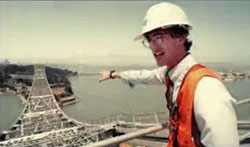Brian Maroney: 3 cheers for those who get it done

In chatting with longtime Caltrans bridge engineer Brian Maroney, it quickly becomes evident that he believes in giving credit where credit is due.
“I just feel so lucky,” he says about his graduate school adviser at Colorado State University. “I literally still think about him and try to emulate the things that he did.”
And:
“Then I came here to Caltrans at just the right time with just some wonderful, wonderful – more than supervisors, you know? It wasn’t a job to them. All of them.”
And:
“When I teach at (the University of California,) Davis, I always tell the young people, ‘It doesn’t matter if you have a Ph.D. from MIT. You can do really fancy analysis, you can do fancy design, you can do fancy everything. State-of-the-art stuff. But at the end of the day, who builds our bridges? Hard-working, respectable laborers, carpenters, ironworkers, superintendents. I have learned so much from ironworker and carpenter foremen. I mean, these people have been doing it a long time. They’re incredibly practical.”
The amiably loquacious Maroney is no slouch himself. He is the toll bridge seismic retrofit chief bridge engineer for Caltrans, has served as the chief engineer of the new eastern span of the San Francisco-Oakland Bay Bridge, and received the Greta Ericson Distinguished Service Award by the (Bay Area) Metropolitan Transportation Commission, among many other honors and accomplishments.
During his 36-year Caltrans career, though, there has never been anything quite like the Loma Prieta earthquake and his arrival at the Cypress structure the morning after it had collapsed. Forty-two people died there.
“You’re like a detective,” Maroney, then an associate bridge engineer, tells Jo Ann Cullom in his Jan. 5, 1990, interview for the Loma Prieta Oral History project. “You show up after the murder and you’re trying to imagine who did it, and that kind of thing, and what happened. That’s what I do.”
"We are going to perform, as a state, a lot better because of the investment that elected officials and the good taxpayers of California paid into."
He spent days and nights at the site, making decisions about what parts were safe to climb on or crawl in, and whether rescue and recovery operations would have to stop until more safety steps (such as shoring) were taken.
“Cypress was pretty rough,” Maroney recalled recently. “It was pretty bad. Nobody had an understanding what was going on down there. And by the time we figured it out, it’s like, oh crap. … After all these years, I’m getting a little emotional, just thinking about it again. It happens every time.”
On a much brighter note, he said of Cypress: “It’s the reason I have a doctorate.” The catastrophic event gave him the incentive and desire to learn as much as possible. “I continue to teach myself new things,” the longtime college professor added.
Characteristically, Maroney praised firefighters who performed gruesome body-removal work at Cypress, saying he thinks they “have a sense of structures” and aren’t prone to taking dumb risks. He also marveled at how brave neighbors took it upon themselves to help.

“There were a bunch of local citizens, and that was not a very wealthy part of Oakland at that time,” Maroney explained. “Now it’s been upgraded, and, I don’t know, wealthy people are coming in and buying out everything. Now there’s this beautiful parkway and dog walk and stuff there. But back then, there were some pretty rough areas there. I worked construction down in Oakland – I always liked Oakland – I was amazed how just local citizens were just trying to help. Really, really cool.”
Maroney joined Caltrans in August 1983, having told the Caltrans panel during his interview: “ ‘I’m not looking for a job. I’m looking for a career that means something,’ ” he recounted. “I had no idea what was in store.”
Outside of work, one thing in store was getting married and having two sons, one now an environmental engineer for FedEx and the other a biomedical engineer who is in nursing school in Miami. Maroney and his wife live in Davis.
Considering the massive retrofitting program Caltrans embarked upon after Loma Prieta and the 1994 Northridge earthquake, and all the seismic safety work he has overseen since, how ready does Maroney think Caltrans is for big earthquakes of the future?
“We are going to perform, as a state, a lot better because of the investment that elected officials and the good taxpayers of California paid into,” he said. “We have reduced risk, really tremendously, up and down the state.”
As the recent interview wound down, the veteran engineer had a few more compliments up his sleeve. “I’ve been blessed,” Maroney said. “I’ve had really wonderful bosses and they have given me interesting work. I don’t think I have ever had a boring job assignment at Caltrans.”
And the feelings are mutual. Colleagues, contractors, mentees and other contemporaries say nice things about Maroney, too.

